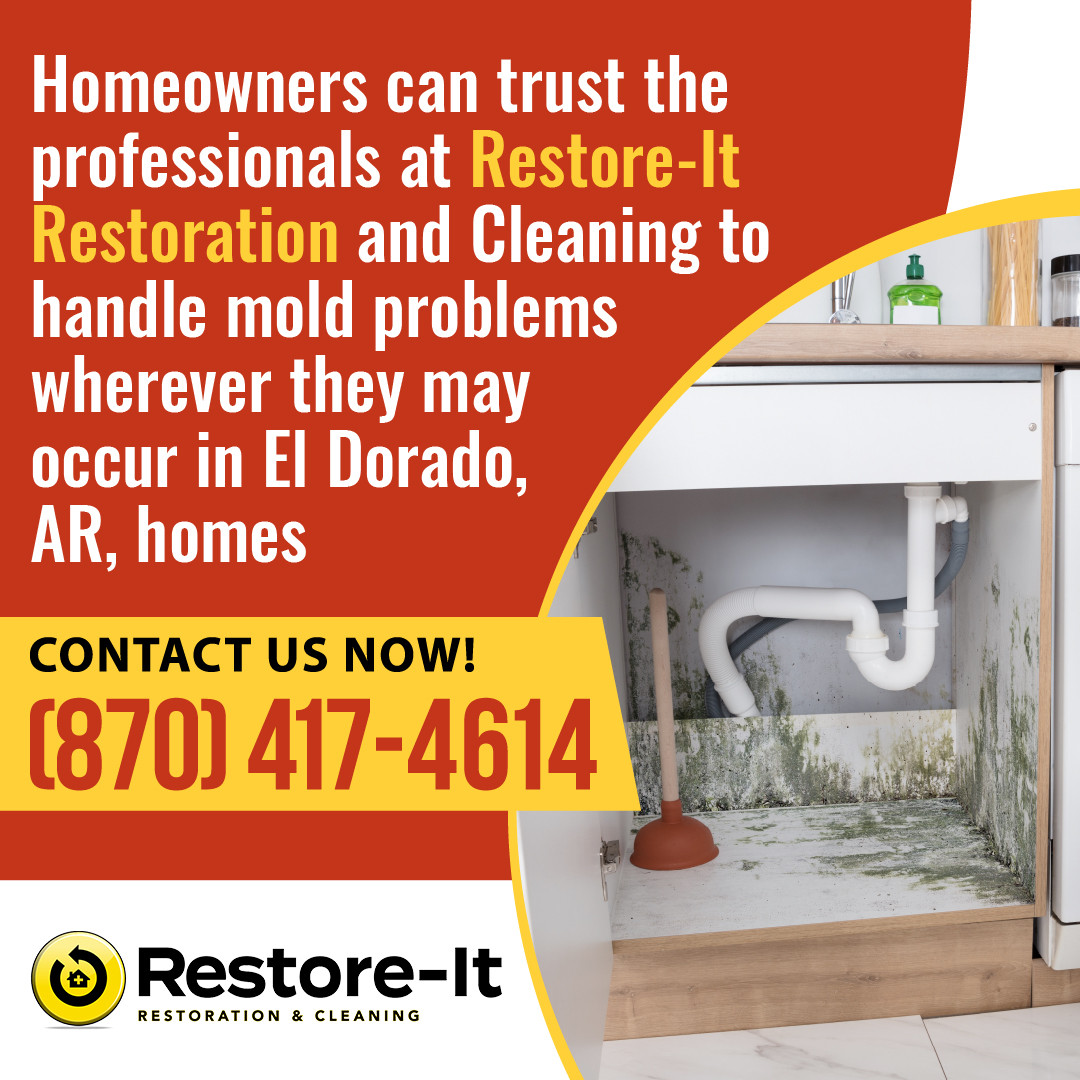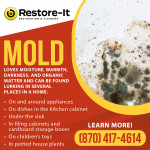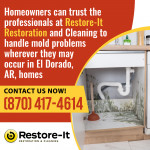Restore-It Restoration and Cleaning, a professional property damage cleanup and restoration company, specializes in a broad range of restoration and cleaning services, including mold remediation.
Carpet is a popular commercial and residential floor covering because it is comfortable, quiet, and available in a variety of colors, textures, and price points. However, carpets can be challenging to keep clean and dry for several reasons:
- Leaks from appliances and supply lines (ice maker, washing machine, dishwasher, faucets, toilets)
- Foot traffic and pet traffic on a rainy day
- Water leaks around windows and doors
- Moisture when outside humidity levels are high
- Beverage spills
- Water from a window air conditioner
- Pet urine
Mold Growth on Carpet
Indoor mold needs moisture, warmth, organic material, and darkness for optimal growth. Carpet is a breeding ground for mold, especially in rooms where sunlight is absent or minimal, air movement is limited, and moisture levels are elevated. A vacant bedroom, a bonus room over the garage, and carpeted areas of the basement are prime locations for a mold infestation.
Mold can spring up overnight when conditions are just right. Mold spores can grow on a wet or damp carpet in as little as 24 to 48 hours, causing permanent damage to the home, not to mention the carpet. The carpet cannot be salvaged and cleaned if mold is not quickly and thoroughly remediated using the proper equipment, cleaning techniques, and mold treatment products. Instead, It must be discarded and replaced with a new carpet or another flooring system.
Signs of a Mold Problem in the Carpet
Mold can thrive on carpeting before the infestation is visible. A pungent, musty odor or irritating smell is a good indication that a mold problem exists somewhere in the home. Mold spores give off a strong odor during the early stages of mold growth.
This musty odor from mold may also indicate poor ventilation in the room or home. As mentioned above, inadequate ventilation can increase the likelihood of a mold infestation. If the smell is traced to the carpet, immediately have the floor covering tested for mold. Early testing and intervention can prevent the situation from worsening.
Once mold enters the advanced stages of growth, it will become visible on the carpet. The texture and color of the carpeting, in conjunction with the hidden location of the mold, may prevent the homeowner from spotting the mold infestation. By the time the mold is visible, the problem is already serious. Look for green, white, or black splotches in the shadows and out-of-the-way places in carpeted rooms. In many cases, the mold has already been growing on, in, and under the padding where moisture is trapped, light is minimal, food is plentiful, and ventilation is non-existent. Mold can also be eaten away at the floor substrate under the padding.
When mold growth has progressed this far, replacing the carpet and padding is the only safe course of action. Also, the floor substrate will need mold remediation to prevent the new padding and carpet contamination.
Tips to Prevent Carpet Mold Growth
Once mold takes hold in carpeting, options are severely limited. The key is to prevent mold growth in carpeting. Below are several effective tips for preserving the quality and health of carpets in the home.
Tip: Prevention of mold growth begins with the installation of the product.
Do not install carpets in rooms that would promote mold growth. If an area is prone to capture or collect moisture, select an alternate floor covering that is moisture resistant. Mold loves the bathroom and all the humidity and warmth present in this room. As a result, carpet in bathrooms is highly susceptible to mold growth. The moldy, mildew smell may be from the bathroom carpet, not the shower stall! Include the kitchen, laundry room, and basement. The exhaust fan over the stove can evacuate much of the heat and moisture generated by the stove. Make sure the exhaust vent for the dryer is clean and flowing freely. Visually inspect the supply lines to the washing machine. Feel the valves and connections for slow leaks.
Tip: Install carpet that is totally synthetic.
Carpet and rugs made of synthetic fibers are mold resistant. Mold can still grow on the grime, dust, food particles, and dirt trapped in the synthetic carpeting. By keeping the carpet clean and disinfected with regularly scheduled seasonal cleanings, mold can be kept to a minimum. The carpet will also look and smell great. Dirt absorbs moisture, so eliminating the dirt will lower the moisture content in the rug or carpet and eliminate food for the mold.
Tip: Install high-quality padding under the carpet.
Install high-quality rubber padding between the floor and the carpet. The anti-microbial properties of this padding hinder mold growth.
Tip: Vacuum frequently.
Dirt is food for mold. Regular vacuuming, ideally two times weekly, removes much of the dirt, grime, pet hair, and food particles that collect on the carpet. In the absence of food, mold grows slowly or not at all.
Tip: Have the carpet professionally tested and evaluated.
Professional mold testing is accurate. Recommendations based on the test results can resolve mold issues in the carpet and the rest of the home. A full-service property damage restoration company can test for mold and remove and discard contaminated carpet and padding. Technicians can also take care of repairing or replacing floor substrate, baseboards, and sheetrock or drywall that has been damaged or ruined by mold.
































